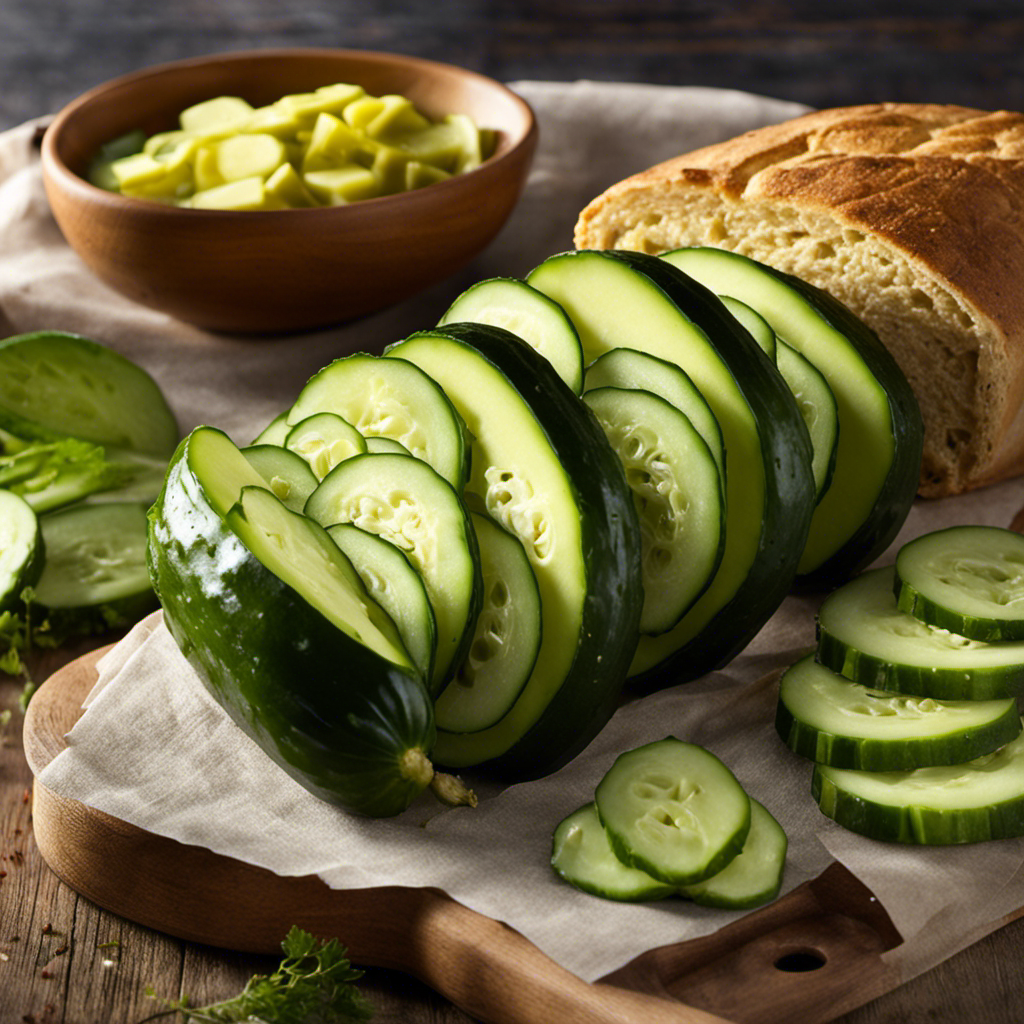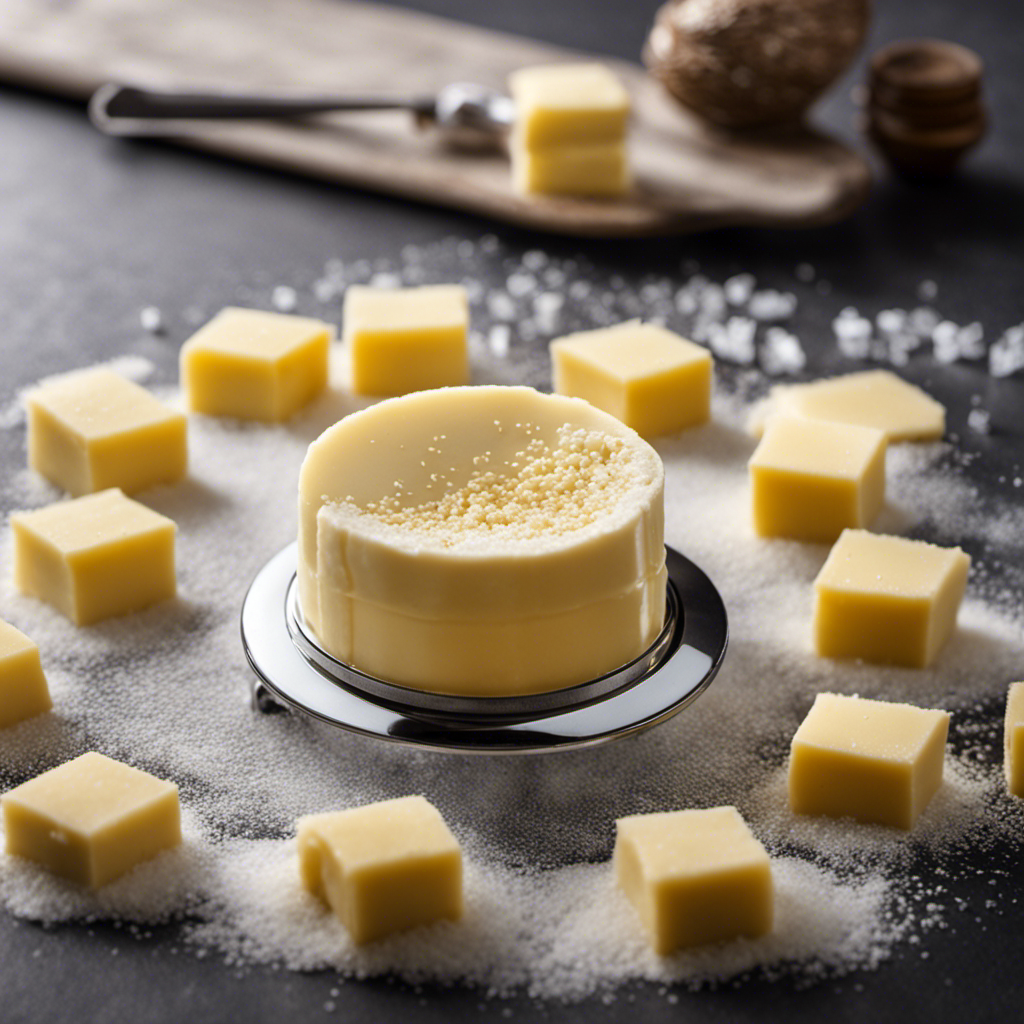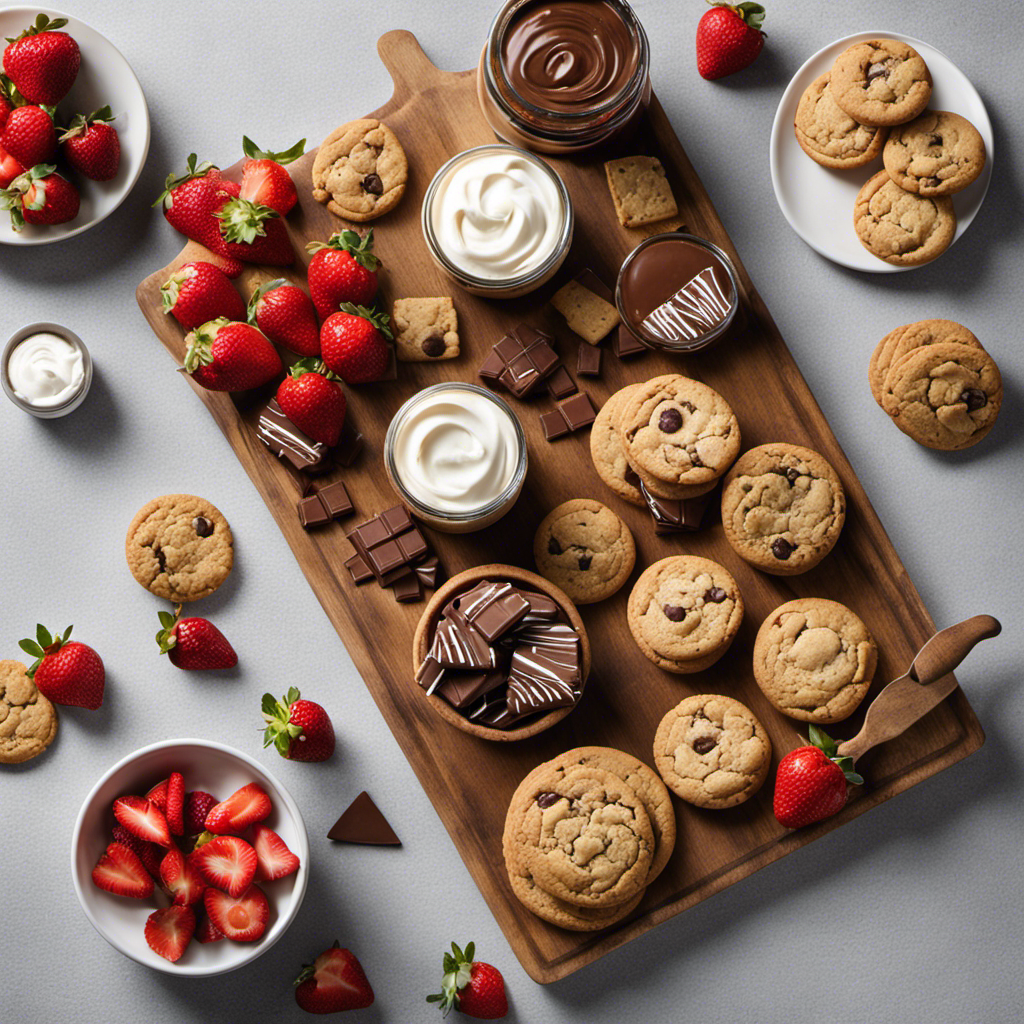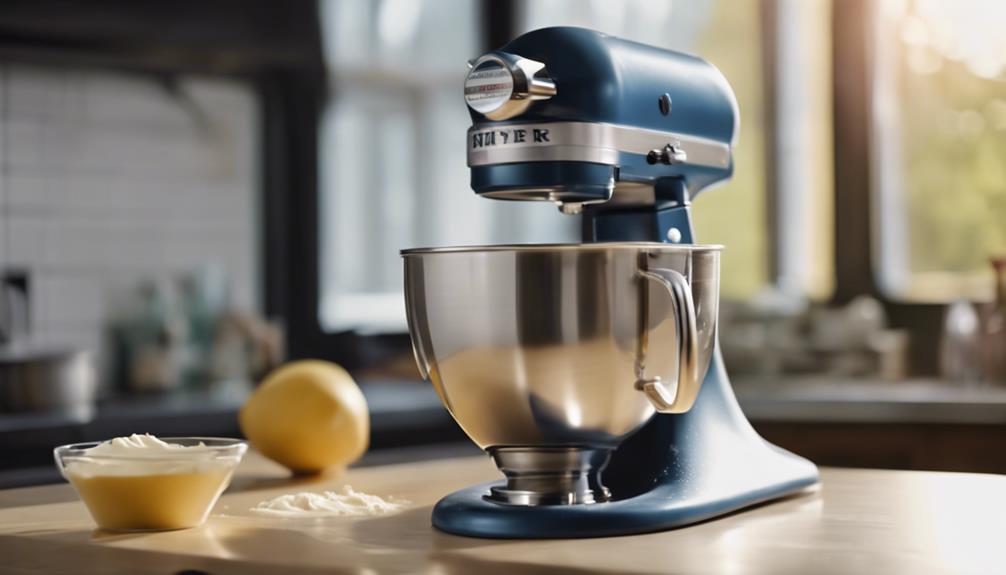In accordance with the traditional saying, ‘No bread is complete without butter,’ the same sentiment applies to pickles.
But have you ever wondered why they’re called bread and butter pickles? In this article, I’ll delve into the fascinating history and origins of these tangy and sweet treats.
From their role in American cuisine to the traditional ingredients used, you’ll discover why bread and butter pickles have become a beloved staple on our plates.
So grab a jar and get ready to satisfy your pickle curiosity.
Key Takeaways
- Bread and butter pickles originated in the United States in the early 20th century and were popular in rural areas of the Midwest and the South.
- The name ‘bread and butter pickles’ is rooted in American culinary traditions and showcases resourcefulness during the Great Depression.
- Regional variations and cultural influences led to the creative naming of bread and butter pickles, such as ‘sweet and sour pickles’ or ‘bread and butter chips’.
- Bread and butter pickles have a sweet and tangy flavor profile and are a popular choice for sandwiches, burgers, and as an ingredient in salads and relishes.
History of Bread and Butter Pickles
The history of bread and butter pickles dates back to the early 20th century. These tangy and sweet pickles have their origins in the United States, specifically in the rural areas of the Midwest and the South.
The name ‘bread and butter’ comes from the Great Depression era when people would make these pickles as a way to stretch their limited food resources. The pickles were made from cucumbers, onions, and a brine of vinegar, sugar, and spices. The sweet and sour flavor combination made them a popular choice for sandwiches, particularly those made with bread and butter.
Over time, bread and butter pickles became a staple in American cuisine, showcasing the cultural influences of preserving and making the most of what you have.
Origins of the Name
When exploring the historical significance of a name, it is fascinating to uncover the cultural influences that shape the way we name things.
The origins of a name can reveal insights into the time period, societal values, and even the geographical location where it originated.
Understanding the historical context and cultural influences behind a name provides a deeper understanding of its significance and helps us appreciate the rich tapestry of human history.
Historical Significance of Name
Have you ever wondered why they’re called bread and butter pickles?
The name has its historical origins deeply rooted in American culinary traditions. Bread and butter pickles are a type of sweet and tangy cucumber pickle that gained popularity during the Great Depression.
The name itself reflects the cultural influences of that time. During the economic hardship, people had to make do with what they had, and bread and butter were staples in many households. These pickles became a frugal and tasty way to stretch a meal.
The pickles were often served alongside bread and butter sandwiches, hence the name. The sweet and sour flavor of these pickles complemented the richness of the butter and added a delightful crunch to the sandwich.
Today, bread and butter pickles continue to be enjoyed for their nostalgic flavor and cultural significance.
Cultural Influences on Naming
Growing up in a time of economic hardship, people creatively named these sweet and tangy cucumber pickles after the staple foods they had on hand. Cultural influences on naming and regional variations played a significant role in the development of the term ‘bread and butter pickles.’
-
Cultural Influences on Naming: The name ‘bread and butter pickles’ reflects the cultural importance of bread and butter as basic, essential foods in many households. The pickles were named after these everyday items to highlight their role as a comforting and familiar accompaniment to meals.
-
Regional Variations: The naming of these pickles also varied across different regions. In some areas, they were called ‘sweet and sour pickles’ or ‘sweet pickles,’ reflecting the regional preference for a sweeter flavor profile. In other regions, the pickles were referred to as ‘bread and butter chips,’ emphasizing their thin, chip-like slices.
-
Evolution of the Name: Over time, the name ‘bread and butter pickles’ has become synonymous with the sweet and tangy flavor profile that defines this type of pickle. Today, these pickles continue to be enjoyed for their unique taste and cultural significance.
The Role of Bread and Butter Pickles in American Cuisine
Bread and butter pickles have gained immense popularity in sandwiches due to their unique combination of sweet and tangy flavor. These pickles add a delightful crunch and a burst of flavor to any sandwich, making them a favorite choice among sandwich enthusiasts.
In terms of their historical origins and evolution, bread and butter pickles have a rich history rooted in American cuisine, with recipes dating back to the early 20th century. Over time, they have evolved to suit different taste preferences and are now available in various forms, such as slices, spears, and relish.
Popularity in Sandwiches
You’ll love how bread and butter pickles add a tangy sweetness to your favorite sandwiches. These pickles have gained immense popularity in deli sandwiches and are now a staple in sandwich condiment trends. Here’s why they are a must-have:
-
Tangy Sweetness: Bread and butter pickles offer a perfect balance of tanginess and sweetness that elevates the flavor profile of any sandwich.
-
Crisp Texture: These pickles are made from thinly sliced cucumbers that are brined in vinegar, sugar, and spices, resulting in a satisfyingly crisp texture.
-
Versatility: Bread and butter pickles complement a wide range of sandwich fillings, from classic deli meats like ham and turkey to vegetarian options like grilled vegetables or tofu.
Adding bread and butter pickles to your sandwich not only enhances the taste but also adds a delightful crunch. They have become a beloved choice for sandwich lovers, creating a delightful and refreshing experience with every bite.
Sweet and Tangy Flavor
Adding bread and butter pickles to your sandwich not only enhances the taste but also adds a delightful crunch. These sweet and tangy pickles have become a staple in American cuisine, with their unique flavor profile and versatility.
The cultural influences and regional variations have played a significant role in shaping the popularity of bread and butter pickles. In the Southern United States, where they originated, the combination of sugar, vinegar, and spices creates a distinct taste that pairs perfectly with fried chicken and barbecue. However, as these pickles gained popularity across the country, different regions began adding their own twists, such as using different spices or adding jalapenos for an extra kick.
The various cultural influences and regional variations have contributed to the widespread love for bread and butter pickles. Transitioning into the subsequent section about the historical origins and evolution, it is fascinating to explore how these pickles came to be and how they have evolved over time.
Historical Origins and Evolution
When it comes to the cultural origins and historical evolution of bread and butter pickles, there is an interesting story to tell. These pickles have deep roots in American culinary history, with their origins tracing back to the early 20th century.
- Immigrants from Eastern Europe brought the tradition of pickling cucumbers to the United States.
- The name ‘bread and butter’ originated from the Great Depression era when pickles made from cucumbers and onions were a cheap and staple food for many families.
- Over time, the sweet and tangy flavor of bread and butter pickles became popular, leading to their widespread adoption in American households.
Understanding the cultural origins and historical evolution of bread and butter pickles provides valuable insights into their significance and enduring popularity.
Now, let’s explore the traditional ingredients used in making these delicious pickles.
Traditional Ingredients Used in Bread and Butter Pickles
To make traditional bread and butter pickles, I use cucumbers, onions, and a mixture of vinegar, sugar, and spices.
These pickles have a rich history rooted in various pickling techniques. Pickling, a method of preserving food in a brine or vinegar solution, has been practiced for centuries. The history of pickling techniques dates back to ancient Mesopotamia and Egypt, where people discovered that soaking fruits and vegetables in a solution of salt, vinegar, or fermented liquids could extend their shelf life.
Over time, different regions developed their own traditional brine recipes, incorporating local ingredients and flavors. In the case of bread and butter pickles, the brine is typically made with white vinegar, sugar, mustard seeds, celery seeds, turmeric, and cloves. These ingredients create a sweet and tangy flavor profile that pairs perfectly with the crispness of the cucumbers and the mildness of the onions.
The Sweet and Tangy Flavor Profile of Bread and Butter Pickles
When it comes to bread and butter pickles, the flavor combination is a key aspect that sets them apart. The sweet and tangy profile of these pickles is what makes them so unique and delicious.
The debate between sweet and tangy is a constant one, with some preferring a sweeter taste while others lean towards a tangier flavor.
Exploring the culinary uses of bread and butter pickles can open up a world of possibilities. You can add them to sandwiches and burgers, or use them as a topping for salads. They can even be used as a flavorful ingredient in dips and spreads.
Flavor Combination Explanation
The flavor combination of bread and butter pickles creates a delicious and tangy taste. These pickles have a cultural significance, often associated with Southern cuisine and traditional American recipes.
The sweet and tangy flavor profile of bread and butter pickles is a result of the unique combination of ingredients used in the pickling process. Here are three key elements that contribute to their distinct flavor:
-
Cucumbers: The cucumbers used in bread and butter pickles are typically smaller and have a sweeter taste compared to other varieties. This adds a refreshing and crisp texture to the pickles.
-
Vinegar: The pickling liquid, which often includes a mixture of vinegar and sugar, gives the pickles their tangy and slightly sweet taste. The vinegar helps to preserve the cucumbers and adds acidity to balance out the sweetness.
-
Spices: Bread and butter pickles are typically flavored with a blend of spices such as mustard seeds, celery seeds, and turmeric. These spices add complexity and depth to the flavor profile, enhancing the overall taste experience.
With their unique flavor combination, bread and butter pickles are a versatile and popular choice for sandwiches, burgers, and relish trays.
Now, let’s dive into the sweet vs. tangy debate and explore the different preferences when it comes to these delightful pickles.
Sweet Vs. Tangy Debate
Now that we understand the flavor combination of bread and butter pickles, let’s delve into the debate between the sweet and tangy flavors that define these pickles.
Bread and butter pickles are known for their unique balance of sweetness and tanginess, creating a delightful taste experience. Some prefer a sweeter profile, where the pickles are made with more sugar and spices, resulting in a rich and syrupy flavor. On the other hand, others lean towards a tangier version, with a stronger vinegar presence and a zesty kick. The choice between sweet and tangy often comes down to personal preference and regional variations.
In addition to their taste, bread and butter pickles hold cultural significance. They have been a staple in American households for generations, often associated with homemade comfort food and family traditions. The distinct flavor of these pickles adds depth and complexity to a variety of culinary creations.
Speaking of which, let’s now explore the culinary uses of bread and butter pickles.
Culinary Uses Explored
If you’re looking for creative ways to incorporate these flavorful condiments into your meals, try using bread and butter pickles as a topping for burgers or sandwiches. The culinary versatility of bread and butter pickles is truly impressive.
Not only do they add a sweet and tangy crunch to your favorite dishes, but they can also be used in a variety of other ways. Here are three ideas to get you started:
- Chop them up and mix them into potato or macaroni salad for a burst of flavor.
- Use them as a topping for hot dogs or bratwursts to add a refreshing twist.
- Make a batch of bread and butter pickle relish to serve alongside grilled meats or as a condiment for tacos.
In addition to their delicious taste, bread and butter pickles also offer some health benefits. They are made from cucumbers, which are low in calories and high in water content, making them a hydrating and refreshing snack. The pickling process also helps preserve some of the nutrients present in the cucumbers.
How Bread and Butter Pickles Got Their Signature Crunch
You might be wondering how bread and butter pickles achieve that signature crunch. Well, let me enlighten you with some fascinating knowledge.
The secret ingredient for their crunchiness lies in the pickling process itself. Bread and butter pickles are made by slicing cucumbers and soaking them in a mixture of vinegar, sugar, and spices. This combination creates an acidic environment that helps break down the cell walls of the cucumber, resulting in a firm texture.
Additionally, the sugar in the brine caramelizes during the pickling process, adding a delightful crunch to the pickles. It’s the science behind the crunch that makes bread and butter pickles so irresistible.
Bread and Butter Pickles Vs. Dill Pickles: What’s the Difference
The main distinction between bread and butter pickles and dill pickles lies in their flavor profiles. Bread and butter pickles have a sweet and tangy taste, with hints of onion and mustard seeds. On the other hand, dill pickles have a more savory and briny flavor, thanks to the dill and garlic used in their preparation.
In terms of texture, bread and butter pickles are typically sliced thinly and have a crisp texture, making them perfect for sandwiches and burgers. Dill pickles, on the other hand, are often left whole or cut into spears, and have a crunchier texture that adds a satisfying bite to dishes like salads and charcuterie boards.
To summarize, the key differences between bread and butter pickles and dill pickles are their flavor profiles and textures. The former is sweet and tangy, while the latter is savory and briny. These distinctions make each type of pickle unique and suited for different culinary uses.
Now, let’s explore some popular uses for bread and butter pickles.
Popular Uses for Bread and Butter Pickles
One popular way to enjoy bread and butter pickles is by adding them to a classic deli sandwich. The sweet and tangy flavor of the pickles complements the savory ingredients in the sandwich, creating a perfect balance of flavors. But bread and butter pickles aren’t just limited to sandwiches. They can be used in a variety of dishes to add a burst of flavor. From topping burgers to adding them to potato salad, the versatility of bread and butter pickles is endless.
Cultural influences on pickling techniques have played a significant role in shaping the flavors and methods used in creating bread and butter pickles. Different regions have their own unique twist on pickling, resulting in variations in taste and ingredients. For example, in the Southern United States, bread and butter pickles are often made with onions and peppers, giving them a spicy kick.
In addition to their delicious taste, bread and butter pickles also offer health benefits. They are low in calories and fat, making them a guilt-free snack option. The pickles are also packed with vitamins and minerals, including vitamin C and potassium. These nutrients contribute to a healthy immune system and help regulate blood pressure. So, whether you’re enjoying them on a sandwich or adding them to your favorite dish, bread and butter pickles are a flavorful and nutritious choice.
| Health Benefits of Bread and Butter Pickles | Cultural Influences on Pickling Techniques |
|---|---|
| Low in calories and fat | Southern United States |
| Rich in vitamins and minerals | Spicy variations |
| Supports a healthy immune system | Regional twists |
Regional Variations of Bread and Butter Pickles
Adding onions and peppers to the pickling process gives bread and butter pickles a spicy kick, especially in the Southern United States. Regional variations of bread and butter pickles can be found across the country, each with its own unique twist.
Cultural influences play a significant role in shaping these variations. Here are three examples:
-
Southern Style: In the Southern region, bread and butter pickles are often made with a generous amount of sugar, resulting in a sweeter taste. The addition of jalapenos adds a hint of heat, creating a perfect balance of flavors.
-
Midwestern Twist: In the Midwest, bread and butter pickles are commonly made with mustard seeds. This adds a tangy and slightly bitter taste to the pickles, complementing the sweetness from the sugar.
-
New England Variation: In New England, bread and butter pickles are often made with apple cider vinegar, giving them a slightly fruity and tangy flavor. Additionally, dill is sometimes added for a refreshing herbal note.
These regional variations showcase the diverse culinary traditions and cultural influences that shape the flavors of bread and butter pickles across the United States.
Homemade Bread and Butter Pickle Recipes
In addition to the regional variations of bread and butter pickles, there are also countless homemade recipes that allow for even more customization. These recipes often involve tweaking the ingredients and ratios to suit personal preferences. Some popular variations include adding onions or garlic for extra flavor, or even experimenting with different types of vinegar for a unique twist.
Not only are homemade bread and butter pickles delicious, but they also offer several health benefits. Since they are made from cucumbers, they are low in calories and fat. They also provide a good amount of fiber, which aids in digestion and helps to keep you feeling full. Additionally, the vinegar used in the pickling process has been linked to potential health benefits, such as improved digestion and blood sugar control.
Now that we’ve explored the variations and health benefits of bread and butter pickles, let’s dive into some fun facts and trivia about this beloved pickle variety.
Fun Facts and Trivia About Bread and Butter Pickles
Did you know that bread and butter pickles were originally created as a way to use up excess cucumbers during harvest season? These tangy and sweet pickles have a rich cultural significance and are a favorite in many households.
Here are some fun facts and trivia about bread and butter pickles:
-
Bread and butter pickles got their name because they were traditionally served with bread and butter as a simple and delicious snack.
-
The sweet vs. sour debate is a hot topic when it comes to bread and butter pickles. Some people prefer the tangy and sour flavor, while others enjoy the sweet and tangy combination.
-
Bread and butter pickles have deep roots in American cuisine and are often associated with Southern cooking, where they are a staple in dishes like fried chicken and barbecue.
These pickles have come a long way from being a solution to excess cucumbers. They have become a beloved and versatile condiment that adds a burst of flavor to sandwiches, salads, and more.
Frequently Asked Questions
Are Bread and Butter Pickles Only Popular in America?
Bread and butter pickles are not only popular in America. While they originated in the United States, they can also be found in other countries. However, there may be variations of bread and butter pickles depending on the region.
Can Bread and Butter Pickles Be Made With Different Types of Cucumbers?
Yes, bread and butter pickles can be made with different cucumber varieties. The pickling techniques used can vary, resulting in unique flavors. It’s amazing how a simple cucumber can transform into a tangy, sweet, and crunchy delight.
How Long Do Bread and Butter Pickles Typically Need to Be Pickled Before They Are Ready to Eat?
Typically, bread and butter pickles need to be pickled for about 24 to 48 hours before they are ready to eat. This pickling process enhances their tangy and sweet flavor profile, making them a delicious addition to sandwiches and burgers.
Are Bread and Butter Pickles Typically Served Cold or Can They Be Enjoyed Warm?
Bread and butter pickles can be enjoyed both cold and warm. They add a tangy, sweet flavor to dishes and are great for cooking. There are variations like spicy bread and butter pickles for those who prefer a kick.
Can Bread and Butter Pickles Be Used in Recipes or Are They Mainly Eaten as a Condiment?
Bread and butter pickles can be used in various traditional dishes, adding a tangy and sweet flavor. They can also be creatively incorporated into meals, like salads, sandwiches, or even as a topping for grilled meats.
Conclusion
In conclusion, it’s truly fascinating to delve into the rich history and origins of bread and butter pickles. Who would have thought that these sweet and tangy delights would become an integral part of American cuisine?
The name itself, with its amusing irony, adds an extra layer of charm to these pickles. From their traditional ingredients to their regional variations, bread and butter pickles continue to captivate taste buds across the nation.
So next time you enjoy a sandwich with these pickles, remember the delightful tale behind their name.










